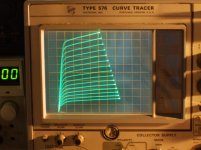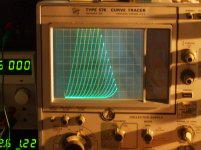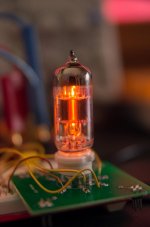Currently I'm reading George Dyson's book Turing's Cathedral in it's 2012 German edition. Chapter 7 describes the development of the IAS machine, an early computer, driven by 3474 vacuum tubes. Among them were 1979 pc. of 6J6 tubes, configured as flipflops. John von Neumann (Johann Neumann von Margittai, as he was Hungarian origin) and his co-designers bought these tubes from WWII military surplus, as Dyson says.
The 6J6 caught my interest, as it has been my very first contact with tube circuitry in my early youth. It's got a rather unusual construction: It has a rectangular cathode sleeve, both triodes were places at the the long sides of this rectangle each. Does anyone know the application(s) it has originally been designed for? And, as the book and some other informations I got gave me some thinking, am I right in my assumption that this tube was the first one with the 7-pin B7G socket, and that B7G tubes in general were preceeding the B9A Noval tubes?
Best egards!
The 6J6 caught my interest, as it has been my very first contact with tube circuitry in my early youth. It's got a rather unusual construction: It has a rectangular cathode sleeve, both triodes were places at the the long sides of this rectangle each. Does anyone know the application(s) it has originally been designed for? And, as the book and some other informations I got gave me some thinking, am I right in my assumption that this tube was the first one with the 7-pin B7G socket, and that B7G tubes in general were preceeding the B9A Noval tubes?
Best egards!
I see RCA registered the 6J6 in Sept 1942 (file # 302 RMA, JETEC, JEDEC),
along with 6AG5 (a re-registration of this type number from Arcturus for another tube type that was dropped in 1939), and type 5R4.
The RCA registration mentions 6J6 for use as an RF amplifier or oscillator/mixer in class C and also gives AF operating data (horrible curves for audio though).
Seeing as the 6J6 base is 7BF, I would guess that bases like 7AT (1AQ5, 1R5), base 7AV (1S4) and base 7B (6A6, 6E6, 53, 5608A) (then bases 7BA, 7BB, 7BC, 7BD ) probably came before it, assuming the base #s were assigned sequentially. (some Octal types in there with 7__ bases too, like 7AA, 7AB, 7AC ... and a medium 7 pin base 7A for type 59 )
Types 1R5 and 1S4 registered by RCA in Nov 1939. ( RMA # 222)
There is a re-registration of 6J6 by RCA in 1949, and a new registration of the 6J6A in 1956 by GE.
along with 6AG5 (a re-registration of this type number from Arcturus for another tube type that was dropped in 1939), and type 5R4.
The RCA registration mentions 6J6 for use as an RF amplifier or oscillator/mixer in class C and also gives AF operating data (horrible curves for audio though).
Seeing as the 6J6 base is 7BF, I would guess that bases like 7AT (1AQ5, 1R5), base 7AV (1S4) and base 7B (6A6, 6E6, 53, 5608A) (then bases 7BA, 7BB, 7BC, 7BD ) probably came before it, assuming the base #s were assigned sequentially. (some Octal types in there with 7__ bases too, like 7AA, 7AB, 7AC ... and a medium 7 pin base 7A for type 59 )
Types 1R5 and 1S4 registered by RCA in Nov 1939. ( RMA # 222)
There is a re-registration of 6J6 by RCA in 1949, and a new registration of the 6J6A in 1956 by GE.
Last edited:
It could be one of the earliest --your right B7G first then B9A but you are forgetting a much used wartime tube in radar etc the EF50 its a lot more famous than the 6J6 and all glass construction ( in a case ) see-
The EF50, the tube that helped to win the War
You could of course hit back and say the "Acorn " 955, I have several boxed USA issue 1942 that's a much earlier design but you can see the progression .
The EF50, the tube that helped to win the War
You could of course hit back and say the "Acorn " 955, I have several boxed USA issue 1942 that's a much earlier design but you can see the progression .
IBM 604
Used 900 to 1500 6J6s, all mounted as complete flip-flop assemblies for easy maintenance. Logic, if it could be called that was 1-2-4-8 BCD. The number of 6J6s depended on how deep the customers pockets were, all IBM equipment at that time was rented or leased, not sold. Its probably not a coincidence, the Waterman Scopes used 6J6s in the vertical amp & time base. BW was about 200 KHz, OK for the 604. My recollection is it ran at 50 KHz.
The 6J6 heater voltage was regulated by a saturated reactor driven by a 6L6.
Used 900 to 1500 6J6s, all mounted as complete flip-flop assemblies for easy maintenance. Logic, if it could be called that was 1-2-4-8 BCD. The number of 6J6s depended on how deep the customers pockets were, all IBM equipment at that time was rented or leased, not sold. Its probably not a coincidence, the Waterman Scopes used 6J6s in the vertical amp & time base. BW was about 200 KHz, OK for the 604. My recollection is it ran at 50 KHz.
The 6J6 heater voltage was regulated by a saturated reactor driven by a 6L6.
I haven't found a lot of free documentation about early vacuum tube digital computer circuits. There is a PDF scan http://www.piercefuller.com/library/700circ.html of a IBM manual; the 2D21 tyratron drives the solenoids on printers and punched cards peripherals, logic is mostly made of 5687, 5965, 6530 and 5998 twin triodes. According to the pictures in the manual, the maintenance must have been anything but trivial.
6530? typo?
6197 appears to be a common computer tube. A high gain pentode (6CL6), probably was used for core memory readout. Nice curves for audio, cheap and plentiful. A good functional sub for 12BY7, except higher heater current (not working for Citation II).
curves:
6197 appears to be a common computer tube. A high gain pentode (6CL6), probably was used for core memory readout. Nice curves for audio, cheap and plentiful. A good functional sub for 12BY7, except higher heater current (not working for Citation II).
curves:
Attachments
Last edited:
logic is mostly made of 5687, 5965, 6530 and 5998 twin triodes......6530? typo?
I once was given over 100,000 tubes in exchange for helping clear out the warehouse where they were stored so it could be demolished and a housing project could be built on the land.
All of the tubes were loose, unboxed, and stored in boxes, 55 gallon drums, or just laying loose on the shelves. The property had been abandoned for nearly 10 years, vandals had broken out all the windows as well as lots of the tubes. Rats had eaten most of the boxes, and pigeon poop was all over everything.
About half the tubes were "military spares" and the other half were "computer spares." Here's a few pictures. One is of an unopened box from the Douglas Aircraft Company to an Air Force Base dated Aug 16, 1937. Some of the tubes in the box were Western Electric, and they sold for good money. There is also a picture of the sorting rack I used for sorting the tubes. I had 4 of these, and due to the nature of the job, all work was done outdoors.
I got plenty of 5687, 5963, 5964, 5965, 5844, 6463, 7044, and 7119. No 6530's.
Note that the 6J6 came in two flavors with cathodes designed for long periods of zero plate current (needed for logic use) The 5964 is a 6J6 with a special cathode coating for computer use. The 5844 is a similar tube but it actually contains two separate triodes each with their own cathode and a slightly lower Mu. There is also a mil spec 6J6, the 6101. I found some of them in the military spares section of the warehouse.
There is a computer version of the 12AU7, the 5963, and the 5965 is a computer version of the 12AY7.
The 5687, 6463, 7044 and 7119 are all computer tubes with higher emission and plate current capabilities.
I spent much of 5 years going through large boxes full of random tubes, and testing them for use in audio circuits. ALL of the tubes I mention in this post work fine in audio applications, so I saved a box full of each.
What are the odds of finding a tube with a spare heater inside the glass....what are the odds of finding TWO of them, both 6AG5's and both good.
Many of the tubes were just too ugly, dirty, or broken to use.....and some just needed to be MELTED!...but then you find THESE!
Attachments
-
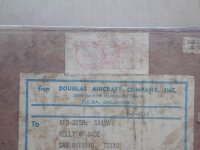 DSCN2377.JPG671.8 KB · Views: 575
DSCN2377.JPG671.8 KB · Views: 575 -
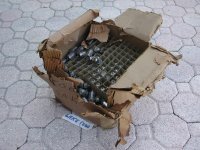 DSCN2370.JPG682 KB · Views: 563
DSCN2370.JPG682 KB · Views: 563 -
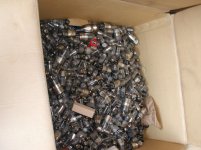 DSCN2507.jpg327.5 KB · Views: 593
DSCN2507.jpg327.5 KB · Views: 593 -
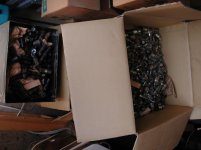 DSCN2508.jpg212.4 KB · Views: 327
DSCN2508.jpg212.4 KB · Views: 327 -
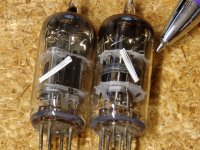 two_of_them.jpg164.6 KB · Views: 358
two_of_them.jpg164.6 KB · Views: 358 -
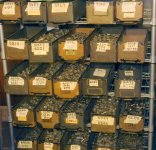 Sorting_rack_A.jpg61.8 KB · Views: 377
Sorting_rack_A.jpg61.8 KB · Views: 377 -
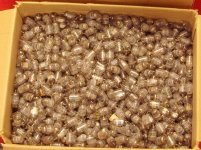 Box_o_tubes.jpg195.8 KB · Views: 356
Box_o_tubes.jpg195.8 KB · Views: 356 -
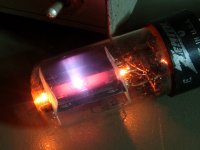 BluRay.jpg103.5 KB · Views: 308
BluRay.jpg103.5 KB · Views: 308 -
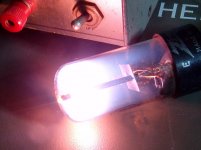 Plasma.jpg101.2 KB · Views: 289
Plasma.jpg101.2 KB · Views: 289 -
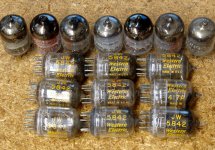 WE5842.jpg185.1 KB · Views: 344
WE5842.jpg185.1 KB · Views: 344
@Kay -- we (wife and me) visit Munich every 3 or 4 years -- and in addition to the Alte Pinakothek etc we always visit the Deutsches Museum -- which has wonderful exhibits of vacuum tube technology computers. One of the great technology museums of the world.
@george -- we should co author a book -- you sketch and write and I will edit -- "Vacuum Tales" -- I have a collection of the invention of technologies books which start with alchemy!
@george -- we should co author a book -- you sketch and write and I will edit -- "Vacuum Tales" -- I have a collection of the invention of technologies books which start with alchemy!
Last edited:
What are the odds of finding a tube with a spare heater inside the glass....what are the odds of finding TWO of them, both 6AG5's and both good.
That's something special indeed!
Besides some loose parts of mica and glass I never found strange objects in a tube. But I guess many more tubes gone through your hands than through mine. I did rescue some big boxes of mainly TV tubes from being thrown away by the "Rotterdams Radio Museum" where I was one of the volunteers. It took me 3 days to sort them all out. Our livingroom was full of them and my knees got pretty sore in the process...but I enjoyed doing it. Biggest 'catch': a good ECC808.
Used 900 to 1500 6J6s, all mounted as complete flip-flop assemblies
I recently asked me "why always build just amp circuits? No other ideas?". So my mind turns now about some hot logic projects. What about a clock, just dividing down the 50Hz from grid? Or a table calculator, well ok just able to add and substract numbers up to 1024, but with some nice nixies? Well ok that may be a big rock project, about 70 tubes I guess...
The ULTIMATE hot logic project would be a CD reader, all logic in glass, including a helium neon laser (but that would be a lifetime project).
How ever, I recently played with the super cheap russian version of the 6J6, the 6N15P, to get first experience with flipflops, inverters, AND/OR-gates and the like. As soon as I applied the heater voltage, I fell in love with the 6N15P - no other double triode glowes so beautiful!!
Attachments
@Kay -- we (wife and me) visit Munich every 3 or 4 years -- and in addition to the Alte Pinakothek etc we always visit the Deutsches Museum -- which has wonderful exhibits of vacuum tube technology computers. One of the great technology museums of the world.
YES, couldn't agree more

 ! Maybe you also want to visit the Technoseum at Mannheim next time that also displays ancient computer technology, or the DTMB (Deutsches Technik-Museum, Berlin).
! Maybe you also want to visit the Technoseum at Mannheim next time that also displays ancient computer technology, or the DTMB (Deutsches Technik-Museum, Berlin).Best regards!
... just went over recently in the web, also super interesting:
technikum29 Computer-Museum, historische Computerwelten: Lebendige Zeitreise - technikum29
all the best, Adrian
technikum29 Computer-Museum, historische Computerwelten: Lebendige Zeitreise - technikum29
all the best, Adrian
I recently asked me "why always build just amp circuits? No other ideas?". So my mind turns now about some hot logic projects. What about a clock, just dividing down the 50Hz from grid?
Has been done yet
Best regards!
Addendum: The counters and flipflops in this beast feature the Philips E90CC tube, a miniature double triode that share the pinout with the 6J6/ECC91 and is very similar to it per it's data and curves. It has been dedicated especially for computer use, hence can cope with operating without plate current for a long time. The 6J6 can't, hence proved rather unreliable in the IAS machine. The E90CC is of different construction, too: Both triodes are mounted vertically around a single cathode, the envelope is taller. Same with E92CC, another European computer tube.
Best regards!
Best regards!
There is some interesting stuff here about the 6927/6J6L, the long life version, guaranteed for 50,000 hours ...
https://tubedata.wernull.com/other/Ericsson_LM/EricssonLM_LonglifeTubes2_1965.pdf
https://tubedata.wernull.com/other/Ericsson_LM/EricssonLM_LonglifeTubes2_1965.pdf
WOW- what a cool project !!Has been done yet ! Sorry, pages are in German .

Super impressive!
I counted 102 valves. I guess the inventor spent YEARS to realize it.
And as a Swiss men, pages in german are even prefered for me
Addendum: The counters and flipflops in this beast feature the Philips E90CC tube [...] It has been dedicated especially for computer use, hence can cope with operating without plate current for a long time. The 6J6 can't [...]
Best regards!
hmmm... do you think that is still a problem for a clock built with 6N15P's (as they cost only 0.80$)? In a digital clock, every triode will be turned on periodically, at least every 12 hours, shouldn't that avoid shortened lifetime?
I fell in love with the 6N15P - no other double triode glowes so beautiful!!
There are a few other dual tubes that share this exposed cathode construction. The only number that I can remember now is the 6X8 triode/pentode. There was a tall septar based RF dual pentode or tetrode that had an exposed cathode but I don't remember the number.
Too many tubes.....not enough working brain cells left.
- Status
- This old topic is closed. If you want to reopen this topic, contact a moderator using the "Report Post" button.
- Home
- Amplifiers
- Tubes / Valves
- 6J6 and it's history
